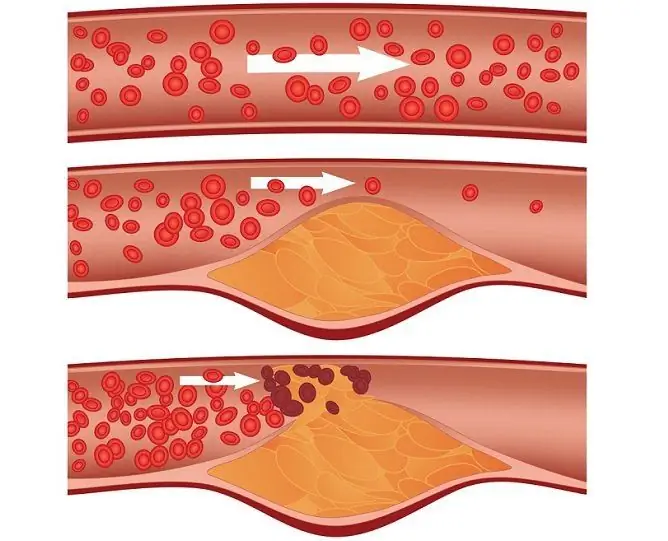- Author Rachel Wainwright [email protected].
- Public 2023-12-15 07:39.
- Last modified 2025-11-02 20:14.
Fecal incontinence

Fecal incontinence is the loss of control over the bowel movement caused by various disorders and injuries.
Causes of fecal incontinence
The main cause of fecal incontinence is a disturbance in the functioning of the muscle pulp and the inability to retain contents in the colon.
The latching apparatus must hold the contents of the intestine, which are liquid, solid and gaseous. Feces are retained inside the rectum due to the interaction of the receptor apparatus and the anal canal, which is carried out with the help of nerve endings, the spinal cord and the muscular apparatus.
The main causes of fecal incontinence have different etiologies and can be both congenital and acquired pathologies. These reasons include:
- anatomical pathologies, including malformations of the anal apparatus, rectal defects and the presence of fistulas in the anus;
- organic trauma received after childbirth, brain damage;
- mental disorders, including neurosis, hysteria, psychosis, schizophrenia, etc.;
- the presence of serious diseases and complications after them (dementia, epilepsy, manic syndrome, etc.);
- traumatic injuries of the locking device, including operating trauma, domestic injuries and falls, rectal ruptures;
- acute infectious diseases that cause diarrhea and fecal impaction;
- neurological disorders caused by diabetes mellitus, pelvic injuries, tumors of the anus, etc.
Types of fecal incontinence
Fecal incontinence in adults and children differs in etiology and type of anal incontinence. The following types of incontinence can be distinguished:
- regular excretion of feces without the urge to defecate;
- fecal incontinence with the urge to defecate;
- partial incontinence of fecal masses during physical exertion, coughing, sneezing, etc.;
- age-related fecal incontinence under the influence of degenerative processes in the body.
Fecal incontinence in infants is a normal condition in which the child does not yet have the ability to contain bowel movements and gas. If fecal incontinence in children lasts up to 3 years, then it is necessary to consult a doctor, as disorders and pathologies may be detected.
Fecal incontinence in adults is usually associated with the presence of nervous and reflex pathology. Patients may develop anal insufficiency, which is caused by a violation of the external sphincter and pathological incontinence of the contents of the filled rectum.
With disturbances in innervation, fecal incontinence in adults occurs at the time of loss of consciousness, that is, during sleep, fainting and in stressful situations.
Receptor fecal incontinence in the elderly is observed in the absence of urge to defecate caused by lesions of the distal rectum and the central nervous system. Fecal incontinence in the elderly is usually observed after impaired coordination of movements, mental abnormalities and degenerative processes.
In order to prescribe the most correct treatment, it is necessary to accurately determine the type of fecal incontinence - congenital, postpartum, traumatic and functional.
In women, fecal incontinence can be caused by damage to the anal sphincter after childbirth. As a result of postpartum disorders, there is a rupture of the perineum and further suppuration, which leads to the development of dysfunction of the anal apparatus.
Diagnosis of the disease
To determine an accurate diagnosis and establish the correct type of fecal incontinence, the attending physician prescribes diagnostic tests, and also conducts an examination for the presence of anatomical, neurological and traumatic disorders of the anal apparatus.
The therapist and proctologist prescribe a study of the sensitivity of the anus, sigmoidoscopy, ultrasound and magnetic resonance imaging.
Fecal incontinence treatment

The first step in treating fecal incontinence is to establish regular bowel movements and normal functioning of the gastrointestinal tract. For the patient, not only the correct diet is prescribed, but also the diet is adjusted with correction of the diet, its components and quantity.
After the normalization of digestion, drugs are prescribed that stop defecation, including furazolidone and imodium.
The most effective treatment for fecal incontinence will be with the appointment of specific training and exercises to strengthen the anal muscles. The exercise program will train the sphincter and restore the normal functioning of the anal apparatus.
With serious damage to the anal canal and rectum, an operation is prescribed. A colostomy is an operation to surgically connect the colon and abdominal wall. The anal passage is completely sutured, and the patient after surgery can only be defecated in a special removable bag, which is connected to the abdominal wall. Such an operation is performed only in extreme severe cases.
Conservative treatment of fecal incontinence includes drug therapy, electrical stimulation, and therapeutic exercises. Electrical stimulation of the perineum and pulp is aimed at improving the contractile function of the anal muscles, restoring the obturator capacity of the rectum and strengthening the anus. Medicines as part of the main therapy will improve nervous excitability in synapses and normalize the state of muscle tissue. The drugs are prescribed depending on the diagnostic indications and the patient's condition, the type of fecal incontinence and the stage of the disease.
If necessary, a combined treatment of fecal incontinence is prescribed, in which the surgical removal of hemorrhoids and restoration of the rectum are performed.
As an additional therapy, a course of water procedures and Biofeedback can be prescribed, which is aimed at training the anal muscles using a special device and a diagnostic monitor.
YouTube video related to the article:
The information is generalized and provided for informational purposes only. At the first sign of illness, see your doctor. Self-medication is hazardous to health!






